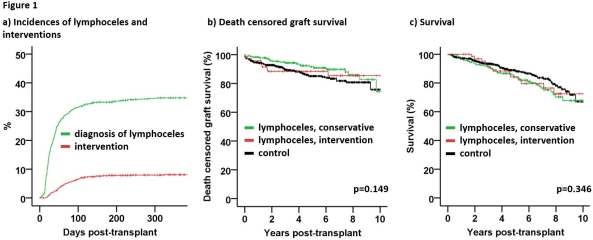Impact of Lymphoceles after Kidney Transplantation on Long-Term Outcomes
Dept. of Nephrology and Medical Intensive Care, Charité
Universitätsmedizin Berlin, Berlin, Germany.
Meeting: 2018 American Transplant Congress
Abstract number: C156
Keywords: Graft survival, Kidney transplantation, Surgical complications, Survival
Session Information
Session Name: Poster Session C: Kidney Technical
Session Type: Poster Session
Date: Monday, June 4, 2018
Session Time: 6:00pm-7:00pm
 Presentation Time: 6:00pm-7:00pm
Presentation Time: 6:00pm-7:00pm
Location: Hall 4EF
Introduction: Despite preventive methods, lymphoceles are common complications occurring in up to a third of kidney transplant recipients (KTR). A variety of risk factors (surgical, medical, donor and recipient factors etc.) have been linked to this entity.
Methods:In this retrospective single center study 867 adult patients, who received either cadaveric or living donor kidneys from 2006-2015, were included. All KTR were routinely screened by graft sonography for lymphocele formation. All KTR with diagnosis of a lymphocele and necessity of intervention were identified and analyzed.
Results: Lymphoceles were found in 307 (35%) KTR, identified with a median time of diagnosis of 29 days (IQR 19-51) post-transplant. Of these 72 (8%) KTR needed intervention, which was performed 22 days (median, IQR 8-55) after diagnosis. Incidence of lymphoceles and time of intervention are shown in figure 1a. Symptomatic lymphoceles were primarily treated by laparoscopic fenestrations (81.9%). The others received either incision with drainage (13.9%) or open surgery (4.2%). In our cohort, lymphoceles were significantly associated with higher age, longer cold ischemia time, deceased donors, DGF and rejection episodes in the univariate logistic regression model. Multivariate analysis, adjusted for all relevant factors, revealed living donation as protective (OR 0.55, p <0.001) and rejection episodes as independent risk factor (OR 1.61, p=0.003) for lymphocele formation. Comparison of KTR with conservatively treated lymphoceles vs. lymphoceles needing intervention vs. controls revealed no difference in death censored graft survival (90.1% vs. 87.5% vs. 86.3%, figure 1b) or patient survival (78.5% vs 77.8% vs. 84.5%, figure 1c) over 10 years. An adjusted multivariate analysis confirmed that lymphocele interventions did not increase the risk for premature graft loss.
Conclusion: Lymphoceles occur frequently after transplantation, the majority within the first 50 days post-transplant and are independently linked with rejection episodes. Formation or intervention of lymphoceles did not lead to poorer graft survival. 
CITATION INFORMATION: Lehner L., Hohberger A., Halleck F., Schrezenmeier E., Khadzhynov D., Budde K., Staeck O. Impact of Lymphoceles after Kidney Transplantation on Long-Term Outcomes Am J Transplant. 2017;17 (suppl 3).
To cite this abstract in AMA style:
Lehner L, Hohberger A, Halleck F, Schrezenmeier E, Khadzhynov D, Budde K, Staeck O. Impact of Lymphoceles after Kidney Transplantation on Long-Term Outcomes [abstract]. https://atcmeetingabstracts.com/abstract/impact-of-lymphoceles-after-kidney-transplantation-on-long-term-outcomes/. Accessed December 13, 2025.« Back to 2018 American Transplant Congress
